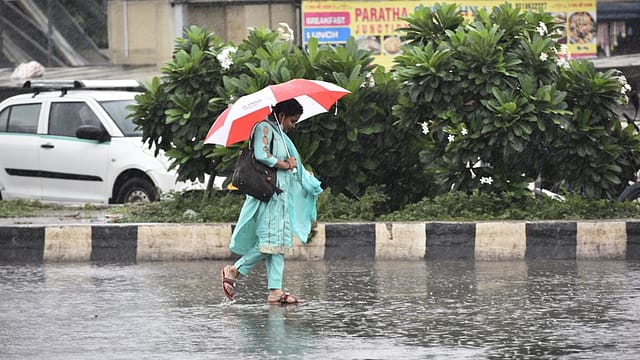Monsoon to be 'below normal' this year: Skymet
ADVERTISEMENT

Private weather forecaster Skymet expects the upcoming monsoon season to be 'below normal' amid an increasing possibility of El Nino this year.
"Likelihood of El Nino is increasing and its probability to become a dominant category during the monsoon is growing large," the weather agency says, adding that El Nino's return may presage a weaker monsoon.
Skymet says it forecasts the upcoming monsoon to be 'below normal' to the tune of 94% (with an error margin of +/-5%) of the long period average (LPA) of 868.6mm for the four-month long period from June to September.
In its earlier projections released in January, Skymet had assessed the monsoon 2023 to be sub-par. The weather agency has now retained its earlier forecast.
Besides El Nino, there are other factors influencing the upcoming monsoon. "Indian Ocean Dipole (IOD) has the potential to steer monsoon and negate the ill effects of El Nino, when sufficiently strong. IOD is neutral now and is leaning to turn moderately positive at the start of monsoon. El Nino and IOD are likely to be 'out of phase' and may lead to extreme variability in the monthly rainfall distribution. Second half of the season is expected to be more aberrated," says Skymet.
January 2026
Netflix, which has been in India for a decade, has successfully struck a balance between high-class premium content and pricing that attracts a range of customers. Find out how the U.S. streaming giant evolved in India, plus an exclusive interview with CEO Ted Sarandos. Also read about the Best Investments for 2026, and how rising growth and easing inflation will come in handy for finance minister Nirmala Sitharaman as she prepares Budget 2026.
In terms of geographical prospects, Skymet expects northern and central parts of the country to be at risk of being rain deficient. Gujarat, Madhya Pradesh and Maharashtra will witness inadequate rains during the core monsoon months of July and August. Punjab, Haryana, Rajasthan and Uttar Pradesh, the agri bowl of North India, are likely to observe less than normal rains during the second half of the season.
India Meteorological Department (IMD), the country's national weather forecaster, had earlier warned of the plausibility of severe heatwaves during March-May 2023. The March to May period is going to be hotter than usual, with enhanced probability of occurrence of heatwave over many regions of Central and adjoining Northwest India, IMD said in February. The met department also issued an advisory to farmers amid higher day temperatures in Punjab, Haryana, and Rajasthan. Unusually hot weather during wheat flowering and maturing period leads to loss in yield.
According to India Ratings and Research (Ind-Ra), elevated temperatures across India could not only affect the country's agricultural output but also keep inflation at elevated levels. This can have an impact on rural demand which has been under stress in the aftermath of the Covid-19 pandemic, says Ind-Ra.
Several U.S. government agencies have warned of the possibility of El Niño later this year, which could lead to poor monsoons, hampering rural India's growth potential.
